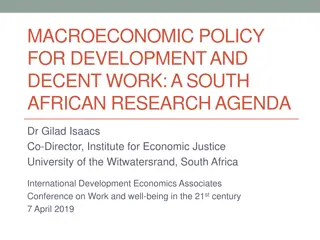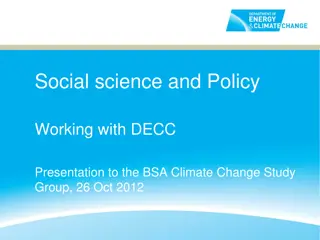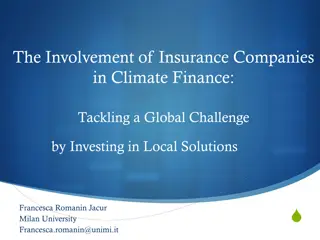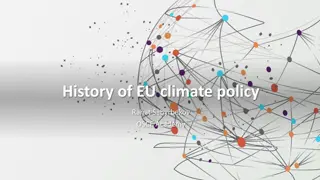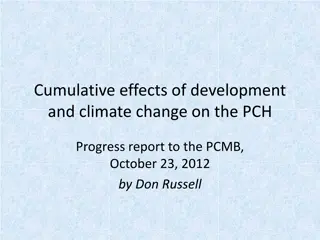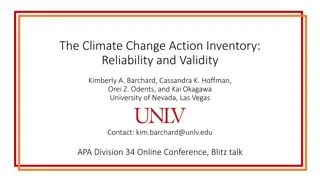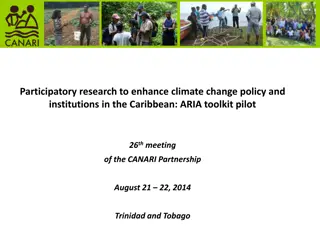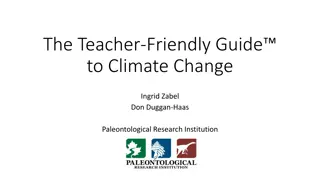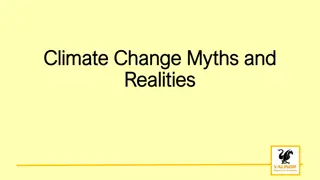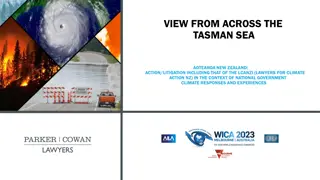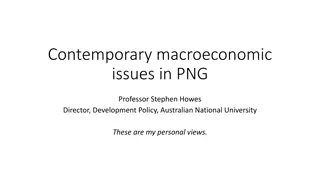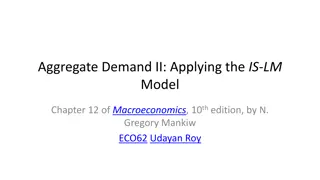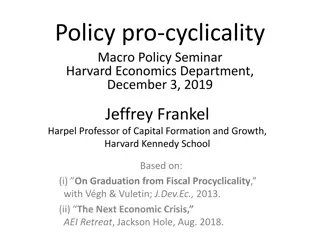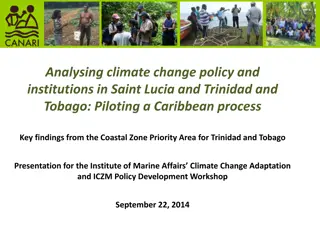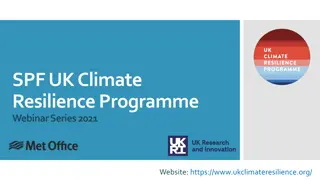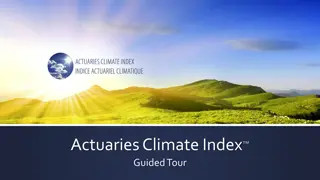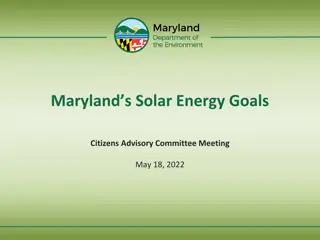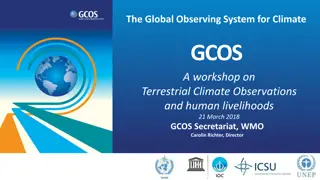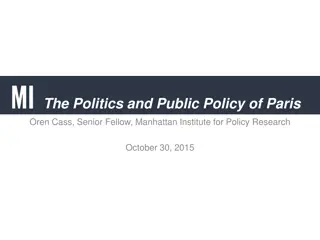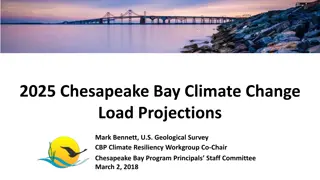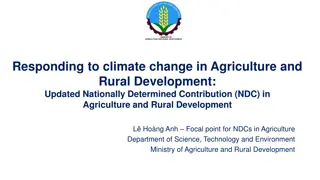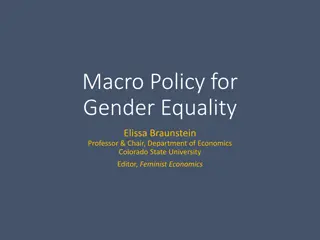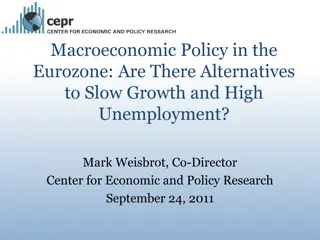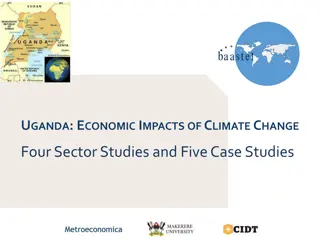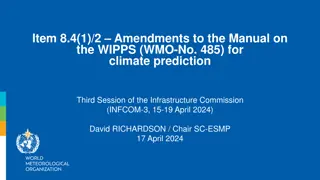Macroeconomic Modeling of Climate Change in Policy Making
In this seminar by Charl Jooste at the Bank of Uganda, the discussion revolves around the essential ingredients for macro models to incorporate climate policy and climate change. The talk highlights the need to augment standard macroeconomic functions, react to price signals, and link macro models with climate systems. It emphasizes the structural interpretation of changes and the theoretical setup for causation in macroeconomic decision-making. The differences and overlap between various models like IAM, CGE, DSGE, and HSM are also explored, focusing on their steady states, dynamics, and data calibration methods.
Download Presentation

Please find below an Image/Link to download the presentation.
The content on the website is provided AS IS for your information and personal use only. It may not be sold, licensed, or shared on other websites without obtaining consent from the author. Download presentation by click this link. If you encounter any issues during the download, it is possible that the publisher has removed the file from their server.
E N D
Presentation Transcript
The Macroeconomic Modeling of Climate Change Bank of Uganda Seminar: April 19, 2023 Charl Jooste
Outline Typography of models used at the World Bank The ingredient for macro-climate interactions Mitigation Example of a carbon tax in South Africa Natural disasters Example of floods in South Africa Example of multiple shocks in South Africa Conclusion
There are a core minimum set of ingredients Macro models need to be able to accommodate both climate policy and climate change Changes to standard macroeconomic functions include Augmenting the production function in several ways Economic agents reacting to price and quantity signals Incorporate deep parameters from climate into macro models Allow policy maker s to be flexible enough to respond to different types of shocks Soft-linking macro models to climate systems or nature-based models These ingredients are standard across IAMs, CGE, DSGE and hybrid- structural models (HSM) This talk is about a standard macroeconomic model for policy making different than IAMs and CGEs
Macroeconomic model setup All models should have a theoretical structure to imply causation Consumers maximize utility subject to constraints Intermediate producers minimize costs subject to constraints Final producers assemble products but face constraints (nominal and real rigidities) too Climate change and climate policy should be embedded in these decisions Reduced-form models may be helpful for forecasting, but not so much for a structural interpretation of changes
Differences and overlap between models IAM CGE DSGE HSM Spreadsheet ??? ?,? ?(?,?) Yes Yes Yes Yes No ??? ?,? :?? + ?? Yes Yes Yes Yes No Steady states Depends Yes/numerical Yes/analytical Yes/numerical No Dynamics ??+1??+1 ??+1 Habits No No Yes Yes No Yes Yes Yes Yes No No No Yes Yes No ????? ? ? Depends No Yes Yes No Stock-flow consistent Depends Depends Depends Yes Depends Typically, 1storder perturbation Linearization Nonlinear Depends Nonlinear Linear (typically no simultaneous feedback) Data Calibrated SAM/calibrated Partially estimated Estimated/tim eseries Calibrated
Rising Stylized representation of climate-macro temperatures Changed rainfall patterns Sea-level change Interest rates and risk premia Extreme weather events Environment and carbon taxes Labor decisions Potential GDP GDP Budgetary outcomes Capital Final prices Global Demand Prices of renewables and hydrocarbons Energy efficiency R&D Adaptation investments and insurance expenditures Productivity Factor prices Income taxes Pollution Emissions
The universe of climate-macro models Distributional impacts Eco-system modules [Land use/forestry and water systems] Supply [Detailed energy system] Energy prices Emissions Pollution HSM Damages [Crop yield] [Flooding] [Hurricanes] Transportation modules Finance risk modules
Some language issues We need to learn new terms to understand climate economics RCPs and SSPs Mitigation and adaptation policies Natural disasters: Damage functions and damage vectors Hazzard, exposure and vulnerabilities Climate co-benefits Double dividend Global circulation models (GCMs) Least-cost optimization energy models
Ingredients for mitigation: Energy mix South African, historical energy mix 200,000 This is our historical energy mix Coal Oil 180,000 Gas Biofuels and waste 160,000 Problem: Build new capacity without relying of fossil fuels Zero carbon technologies 140,000 120,000 KTOE 100,000 80,000 60,000 40,000 20,000 0 1980 1985 1990 1995 2000 2005 2010 2015 Source: OECD
Ingredients for mitigation: Fossil fuel emissions Fossil fuel CO2 emissions 600,000,000 Coal emissions Gas emissions Oil emissions 400,000,000 MN Tons 200,000,000 0 1980 1983 1986 1989 1992 1995 1998 2001 2004 2007 2010 2013 2016 2019 Source: OWID Emission sources from ZAF are dirty Note: Emissions (%) refers to cumulative emissions share
Ingredients for mitigation: Emissions per capita > than average (5 tons) Emissions per capita > 5 45 40 35 30 25 20 15 10 5 0 QAT AIA DEU SXM ZAF IRN BIH IRQ ITA RUS CZE OMN BGR HUN FRO TKM AUT IRL SRB GBR UKR SAU AUS SYC MSR VGB GRL ABW SVN HKG BRN ARE LUX KOR EST JPN POL FIN CHN GRC SVK ESP BHS BHR MNG KAZ AND TTO SPM BMU ISR BLR ATG CAN BES ISL NLD BEL CYP DNK NCL USA MYS LBY SGP TCA KWT TWN NZL NOR
Ingredients for mitigation: Pollution PM2.5 Working days lost 30 8.0% % of 240 working days 6.0% Average PM2.5 WHO standard 20 ug/m3 4.0% 10 2.0% 0.0% 0 1990 1993 1996 1999 2002 2005 2008 2011 2014 2017 2020 1990 1993 1996 1999 2005 2008 2011 2014 2017 2020 2002 Source: Own calculations Source: World Bank Pollution in ZAF is well above the WHO standard. Pollution is problematic because it reduces labor productivity
Ingredients for mitigation: Modeling objectives Build a model that captures electricity decisions subject to constraints Model should be able to estimate emissions from energy use Model should be able to estimate costs and benefits from reducing pollution due to emissions
Ingredients for mitigation: Production functions CGE setup has sectoral production functions; HSM and DSGE typically have aggregate production functions Standard production function with energy (abstract from land for now): ? ? ??? 1 ? ? vs. ??= ????????? ?+ ???? ? ??= ??????? What does this imply for marginal costs? 1 ?? 1 ? ? ? ? ??? ?? ? ?? ? ???= 1 ? ?
Ingredients for mitigation: Production functions For South Africa we really want a measure to incorporate supply constraints We assume that electricity consumed is a function of capital ??= ??? ??= ??=?? ?? Production function becomes ? 1 ??? ??= ?? ???? 1 ?? 1 Approximate energy intensity using capacity ??= ?? ??? ???
Ingredients for mitigation: Production functions Utilization rates drop to zero for large energy deficits The more important energy is for production (higher ?), the lower utilization is for any energy deficit A zero-utilization rate constrains potential GDP significantly
Ingredients for mitigation: Energy demand Several mitigation sources: Electricity (?); Land-use (?); waste (?); transportation (?); flaring (?); industrial processes (??) Consumption is household demand (?) + intermediate consumption (????) Composite consumption bundle 1 ? 1 ?? ? ? = ???? 0 Or in terms of first order conditions ? 1 ?? ?? ? ??? 1 ? ? and ??= ??? ??= ?? 1 ? Aggregate consumption (?) and relative prices together with ? pins down energy demand Aggregate consumption function can take many forms (Keynesian, Habits, PILCH etc.) CES function not a must (can use Stone-Geary, PIGLOG too)
Example outputs on CES forms (e.g., carbon price if initial energy share in consumption is 50% of total consumption: Immediate tax hike) For consumption shares (e.g., fossil fuels) to fall we need a large elasticity of substitution it is tricky when the historical estimated elasticity is not that large ES = 0.2 ES = 1.2 ES = 5.2 Consumption Consumption Consumption 0 0 0 -2 -4 %dev. from baseline %dev. from baseline %dev. from baseline -5 -4 -8 -10 -6 -12 Price1 + 10% Price1 + 30% Price1 + 60% Price1 + 90% Price1 + 10% Price1 + 30% Price1 + 60% Price1 + 90% Price1 + 10% Price1 + 30% Price1 + 60% Price1 + 90% -8 -16 -15 -10 -20 -20 -12 -24 -25 -14 -28 5 10 15 20 25 5 10 15 20 25 5 10 15 20 25 Consumption share 1 Consumption share 1 Consumption share 1 49.6 46 35 %dev. from baseline %dev. from baseline 49.2 %dev. from baseline 44 30 48.8 42 25 48.4 38 15 48.0 36 10 47.6 34 5 32 0 47.2 5 10 15 20 25 5 10 15 20 25 5 10 15 20 25
Ingredients for mitigation: Building capacity If demand exceeds capacity, then building capacity to unlock constraints makes sense Tricky parts: Energy prices are regulated (LCOE > regulated price may reduce incentives to build additional capacity) Electricity is provided by a natural monopoly Modeling of stranded assets due to transition (NPV costs of Kusile and Medupi) World Bank approach: Soft-link macroeconomic model with techno-energy models
Ingredients for mitigation: Co-benefits pollution reduction Total emissions is the sum of fossil fuels consumed multiplied by an emissions factor ???= ??(??,?+ ??,?) ? Total fiscal revenues is a function of volume of emissions multiplied by the carbon tax ??????= ???,???? ? Concentrated particulate matter is a function of fossil fuel use ?? ?3 ???? ????2.5= ?? (??,?+ ??,?) ? Working days lost extensive margin 1564??? 1 ? 0.0046????2.5 ????= ???? Production function should be modified ? 1 ???? ??? 1 ???? 1 ? ??= ?? ???? 1 240 ?? 1
Ingredients for mitigation: A simple carbon tax simulation USD 20 increase in Carbon Taxes GDP responses 3.0 Gaps 0.5 2.5 Unemployment Rate Output Gap Inflation 0.0 % level dev. from baseline GDE HH. Consumption Prvt. Investment 2.0 -0.5 % pt. change 1.5 -1.0 1.0 -1.5 0.5 -2.0 0.0 With existing technologies and international prices, a pure carbon tax feeds mainly through demand -2.5 -0.5 -3.0 -1.0 24 26 28 30 32 34 36 38 40 42 44 46 48 50 24 26 28 30 32 34 36 38 40 42 44 46 48 50 Budgets Trade 6 0 -1 5 Export volumes Import volumes %GDP dev. from baseline -2 4 -3 Budget (%GDP) Current Account Balance (%GDP) % pt. change 3 -4 However, carbon taxes can be used to finance new energy, or support households via a transfer or a reduction in income taxes this can easily offset the negative effects -5 2 -6 1 -7 0 -8 -1 -9 24 26 28 30 32 34 36 38 40 42 44 46 48 50 24 26 28 30 32 34 36 38 40 42 44 46 48 50 % contribution to GVA (deviation from baseline) Value added composition Energy and emissions 2.0 5 GVA AGR IND (OTHR) IND (ENE) SRV Electricity VA Other Energy VA Fossil-fuel emissions 1.5 0 % deviation from baseline 1.0 -5 0.5 -10 0.0 -15 -0.5 -20 -1.0 -25 -1.5 -30 -2.0 -2.5 -35 24 26 28 30 32 34 36 38 40 42 44 46 48 50 24 26 28 30 32 34 36 38 40 42 44 46 48 50
Ingredients for mitigation: A simple carbon tax simulation Emissions Electricity composition 1,800,000,000 100 1,600,000,000 Scenario emissions Baseline emissions 80 1,400,000,000 % total electricity million t 1,200,000,000 60 Coal Oil Gas Ren 1,000,000,000 40 800,000,000 20 600,000,000 400,000,000 0 24 26 28 30 32 34 36 38 40 42 44 46 48 50 24 26 28 30 32 34 36 38 40 42 44 46 48 50 Energy inensity Carbon intensity of energy production 2.4 .38 Scenario emissions Baseline emissions .36 2.0 .34 kWh per 2011 GDP .32 Scenario emissions Baseline emissions 1.6 kg/kWh .30 1.2 .28 .26 0.8 .24 0.4 .22 24 26 28 30 32 34 36 38 40 42 44 46 48 50 24 26 28 30 32 34 36 38 40 42 44 46 48 50
Ingredients for mitigation: A simple carbon tax simulation & reducing PIT USD 20 increase in Carbon Taxes + Reducing direct taxes GDP responses Gaps 2 4 Unemployment Rate Output Gap Inflation 1 3 % level dev. from baseline 0 2 % pt. change -1 1 -2 0 GDE HH. Consumption Prvt. Investment -3 -1 -4 -2 24 26 28 30 32 34 36 38 40 42 44 46 48 50 24 26 28 30 32 34 36 38 40 42 44 46 48 50 Energy and emissions Trade 5 0 Electricity VA Other Energy VA Fossil-fuel emissions 0 -1 Export volumes Import volumes % deviation from baseline %GDP dev. from baseline -5 -2 -10 -3 -15 -4 -20 -5 -25 -6 -30 -7 24 26 28 30 32 34 36 38 40 42 44 46 48 50 24 26 28 30 32 34 36 38 40 42 44 46 48 50
Damages from temperature and precipitation to economic damages Source: Author s
Damage functions: Examples Category Damage Vector (input option 1) Damage Function (functional forms) damage to supply of land type lnd due to flooding Flooding ???? ? + ?2,??? ???? ?2 ??????????,?= 1 + ?1,??? ??? ? + ?2,? ??? ?2 ???????,?= 1 + ?1,? damage to TFP of activity ? in time ? Variation in crop yields damage to productivity of labor type ?, employed in activity ?, at time ? due to human health effects Heat and labor productivity ??? ? ????????,?,?= 1 + ?1,??? damage to productivity of labor type ?, employed in activity ?, at time ? because of heat: Human health and labor supply ??? ? ???????,?,?= 1 + ?1,??? Tourism demand from abroad damage on export demand of the commodity type ? (e.g., tourism): ???? ?+?2,? ???? ?2 ???? ???,?= 1 + ?1,? Source: Dudu et al.
South Africa is not immune to climate change Floods in KZN Droughts in Cape Town Heat What are the economic impacts of climate-related natural disasters? Methodology: Natural disasters in the Caribbean Damages in Pakistan (a modeling approach) Natural disasters and heterogenous capital (Turkey example)
Types of climate damages Average annual incidents (1980-2020) Storms affecting people 40 600000 Floods and storms are the most prevalent 35 500000 30 25 400000 20 15 300000 10 5 200000 0 100000 0 Floods affecting people Wildfires affecting people 250000 6000 5000 200000 4000 150000 3000 100000 2000 50000 1000 0 0 Source: CCKP
Initial conditions matter for the shocks Big shocks to AGR likely to have small GDP impacts Growth on a declining trend hard to respond Sectoral shares Growth 6 100 Potential GDP GDP Long-run growth 5 80 4 Agricultire Industry Services % of value-added % change (y-o-y) 3 60 2 40 1 0 20 -1 -2 0 00 02 04 06 08 10 12 14 16 18 20 00 02 04 06 08 10 12 14 16 18 20 Given small agriculture share; shocks to Agriculture (livestock and crops) will have a small GDP impact. Spill over impacts are also small TFP growth in ZAF has been decreasing (see Fig. 1.6). We assume zero TFP growth going forward
Initial conditions matter for the shocks Eroded fiscal space means little spending available Fiscal balances % GDP 70 60 Debt Revenue Expenditure 50 40 30 20 00 02 04 06 08 10 12 14 16 18 20 Adaptation, emergency expenditure will likely add to already vulnerable debt levels limiting the space to respond to natural disasters
Getting a sense of magnitudes from different sources: Floods Flash floods Riverine floods 0.3% 0.03% Flood damages are relatively small as a share of GDP 0.03% 0.2% % GDP (2020) 0.02% % GDP (2020) 0.2% 0.02% 0.1% The 2022 damage is estimated to cost $1.6 bn (0.5% of 2020 GDP) 0.01% 0.1% 0.01% 0.0% 0.00% 1987 1988 1993 1996 1999 2000 2000 2002 2003 2004 2006 2006 2007 2008 2009 2009 2011 2012 2014 1995 1996 1999 2000 2001 2016 Source: EMDAT Expected damages under different warming scenarios Source: EMDAT 1.0% Some estimates suggest that this event is a 1 in a 40- year event, but with climate change this event is now becoming a 1/20 year event 0.9% Damage (% of exposed assets) 0.400% 0.8% Damage (% of exposed assets) Return period: RCP 2.6 0.350% 0.7% 0.300% 0.6% 0.250% 0.5% Return period: RCP 4.5 0.200% 0.4% Return period: RCP 8.5 0.150% 0.3% 2020 flood 0.100% 0.2% 0.050% 0.1% 0.000% 0.0% No additional warming Source: Own calculations using GAR15 0.5 C of additional warming 1.5 C of additional warming 3.2 C of additional warming 0 200 400 600 800 1,000 1,200 1,400 1,600 Return period Source: Own calculations using GAR15
Getting a sense of magnitudes from different sources: Crops Agriculture (%GDP): 2% (2020) Crops (%Agriculture): 52% Direct losses (%GDP) at most 30%*2%*52% = 0.3%; note agricultural share to GDP is < 1% of GDP when impacts become large Source: Authors & IEc
Getting a sense of magnitudes from different sources: Livestock Agriculture (%GDP): 2% (2020) Livestock (%Agriculture): 33% Direct losses (%GDP) at most 50%*2%*33% = 0.3% Source: Authors & IEc
Getting a sense of magnitudes from different sources: Heat impacts on the largest sector are small(ish) Source: Authors & IEc Source: Authors & IEc Agriculture (%GDP): 2% (2020) Agriculture employment (%total): 5% Industry (%GDP): 31% (2020) Industry employment (% total): 22% Services (%GDP): 67% (2020) Services employment (% total): 73%
Damages to capital - tricky Residual damages equals gross damages less the value of protection ???= 1 ????? Where stock of damaged assets equal ???= 1 ? ??? 1 ???+ ??? Capital stock is adjusted it incorporates damage stocks ??= 1 ??? ?? ?? Capital stock that is not affected by damages is standard ??= 1 ? ?? 1+ ?? ?? Important: Reconstruction investment creates a trade-off Damages will result in average capital productivity effects, not marginal productivity ?
Adaption module: Capital Government invests a discretionary amount into adaptive infrastructure: ?? The stock of adaptive capital follows PIM: ?? The maximum adaptation capital that can be reached is equal to the expected damages (i.e., averages) ???= ?????? 1 ???= 1 ? ?? 1 ???+ ?? ??? ?? ? ???= ?? ? ??? Protection is a concave function that cannot exceed the NPV or max ?? ? ??? ?? ?? ??= ???
Protection is concave Protection level Marginal protection from adaptive capital Mathematically, for ? [0,0.5], the first 25-30% of investments have greater than the average impact .07 ? = 0.25 .06 ? = .5 ? = 0.50 .05 ? = 1 implies linear decline in marginal protection .04 ? = 0.75 .03 ? = 1.00 .02 .01 .00 10 20 30 40 50 60 70 80 90 100 % of Maximum capital
Reconstruction and gestation lags Once shock ? enters, it is not always possible for government to invest ???= (?/?) ? It takes time to rebuild It takes time to disburse (if there are no funds set aside) Kydland and Prescott (1982): Time to build rewrites the PIM as: ??= 1 ? ?? 1+ ?? ?+1 Where the installed structure (?) that takes (?) periods to complete We have different phases of investment: ??= ?=1 ?? is the fraction of resources allocated to project ?? ?+1 that takes ? ? + 1 periods to complete I.e., investment takes translates into finished projects with delays ? ???? ?+1
Heat and agriculture Aggregate productivity is a weighted sum of sectoral productivities: 1 ???,?? ? ??= ?? 0 Sectoral shares are endogenously determined via a translog-cost production function Distinguish between work hours (?) and effective work hours ( ? = 1 ??), which control for heat impacts. is the percentage hours lost due to heat and ? is human capital
Inputs vs. outputs Baseline = extension of existing trends Hard to build in RCP/SSP type baselines (RCP 4.5 is assumed to be representative of trends) Shocks drawn from optimistic vs pessimistic cases Results are sensitive to different GCM models
GCM scenario Source: IEc
Flood damages (RCP 8.5) % deviation from median damages (with reconstruction) Flood damages on GDP SCENARIO: NO ADAPTATION & NO RECONSTRUCTION % deviation from baseline with no damages % deviation from baseline with no adaptation 0.5 1 0.0 Additional damage with no reconstruction 0 -0.5 -1 -1.0 -2 -1.5 -3 -2.0 -4 2020 2025 2030 2035 2040 2045 2050 2055 2060 -2.5 2020 2025 2030 2035 2040 2045 2050 2055 2060 SCENARIO: WITH ADAPTATION AND RECONSTRUCTION % deviation from median baseline with damages 1.2 0.8 Policy maker s loss function to be determined (i.e., how much to weigh the downside vs. upside risk): Based on preferences 0.4 0.0 -0.4 -0.8 2020 2025 2030 2035 2040 2045 2050 2055 2060
Combined impacts [GDP] % GDP % GDP GDP impacts 0.00 0.00 -0.20 -0.20 -0.40 -0.40 -0.60 -0.60 Rainfed crops yield -0.80 -0.80 -1.00 -1.00 Livestock yield -1.20 -1.20 Labor productivity (Heat stress) -1.40 -1.40 Flooding -1.60 -1.60 -1.80 -1.80 Total GDP Impact -2.00 -2.00 Low High Low High Low High 2030 2040 2050
Combined impacts [Consumption] % dev. from baseline % dev. from baseline Consumption impacts 0.50 0.00 0.00 -0.50 Rainfed crops yield -0.50 -1.00 Livestock yield -1.00 Labor productivity (Heat stress) -1.50 Flooding -1.50 Total Consumption Impact -2.00 -2.00 Low High Low High Low High 2030 2040 2050
Combined impacts [Inflation] % dev. from baseline % pt. dev. from baseline % dev. from baseline % pt. dev. from baseline Price impact Monetary policy interest rates Rainfed crops yield 1.50 1.50 0.15 0.15 Livestock yield Rainfed crops yield Labor productivity (Heat stress) Livestock yield 1.00 0.10 1.00 0.10 Flooding Labor productivity (Heat stress) Total Interest Impact Flooding 0.50 0.05 Total Price Impact 0.50 0.05 0.00 0.00 -0.50 0.00 -0.05 0.00 Low High Low High Low High Low High Low High Low High 2030 2040 2050 2030 2040 2050
Combined impacts [Debt] % GDP % GDP Public debt Rainfed crops yield Livestock yield 0.50 0.50 Labor productivity (Heat stress) 0.45 0.40 0.40 Flooding 0.35 0.30 Total Debt Impact 0.30 0.20 0.25 0.20 0.10 0.15 0.10 0.00 0.05 -0.10 0.00 Low High Low High Low High 2030 2040 2050
Summary Overall aggregate impact tends to be small as a share of GDP, but cumulative losses scale up i.e., significant PV loss Results conditional on standard MP and FP responses Scaled up reconstruction and adaptation investments may not be possible if debt is large Macro results hide regional impacts i.e., the poorest of the poor are affected more








